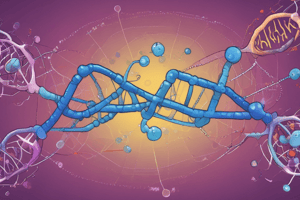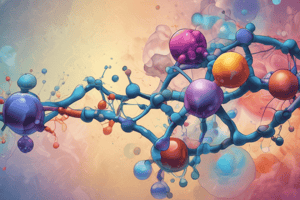Podcast
Questions and Answers
What happens to all bases after a base addition?
What happens to all bases after a base addition?
Move one position to the right.
What happens to all bases after a base deletion?
What happens to all bases after a base deletion?
Move one position to the left.
Which type of mutations could frame shift mutations lead to?
Which type of mutations could frame shift mutations lead to?
- Point mutations
- Missense mutations
- Nonsense mutations
- Both missense and nonsense mutations (correct)
What is the result of adding a C between the C and U in the base sequence GCG-CUA-GAG?
What is the result of adding a C between the C and U in the base sequence GCG-CUA-GAG?
What are the three components that each nucleotide is composed of?
What are the three components that each nucleotide is composed of?
What is the result of deleting the C in the second codon of the base sequence GCG-CUA-GAG?
What is the result of deleting the C in the second codon of the base sequence GCG-CUA-GAG?
What connects complementary bases in DNA?
What connects complementary bases in DNA?
DNA replication occurs during the G period of Interphase.
DNA replication occurs during the G period of Interphase.
Helicase untwists and unzips the DNA helix by breaking the _______ bonds.
Helicase untwists and unzips the DNA helix by breaking the _______ bonds.
Match the following RNA types with their descriptions:
Match the following RNA types with their descriptions:
Study Notes
Nucleic Acids
- Nucleic acids are composed of nucleotides.
- Each nucleotide is composed of:
- A phosphate group
- A pentose sugar (deoxyribose in DNA or ribose in RNA)
- Nitrogenous bases (purines and pyrimidines)
- Purines are larger and double-ringed (adenine and guanine)
- Pyrimidines are smaller and single-ringed (cytosine, thymine, and uracil)
DNA Structure
- DNA is a double helix, with two strands of nucleotides connected and twisted.
- Hydrogen bonds connect complementary bases (adenine and thymine, or guanine and cytosine).
The Search for the Genetic Material
- Frederick Griffith (1928) demonstrated transformation, changing the genotype and phenotype of a cell by assimilation of genetic material from an outside source.
- Oswald Avery, Maclyn McCarty, and Colin MacLeod (1944) repeated Griffith's experiment, showing that DNA is the transforming agent.
The Search for the Structure of DNA
- Erwin Chargaff (1947) discovered that the amount of adenine in a DNA molecule is equal to the amount of thymine, and the amount of guanine is equal to the amount of cytosine (Chargaff's Rule).
- Maurice Wilkins and Rosalind Franklin (1952) used X-ray crystallography to determine the shape of DNA, showing that it is a three-dimensional double helix.
- James Watson and Francis Crick (1953) determined the true structure of DNA, winning the Nobel Prize.
Biological Properties of DNA
- DNA carries information from generation to generation.
- DNA must be copied accurately.
- DNA sometimes mutates, and mutations are copied accurately.
- DNA must be translated and its information put into action.
DNA Replication
- Occurs during the S period of interphase.
- Takes place within the nucleus of a eukaryotic cell.
- Involves the production of new DNA from existing DNA templates.
- The original parent strands separate, and new complementary daughter strands are synthesized.
- Helicase untwists and unzips the DNA helix, breaking the hydrogen bonds.
- DNA polymerase builds new DNA nucleotides using a single strand DNA template.
- One strand (3' to 5') is replicated continuously, while the other strand is antiparallel (5' to 3') and replicated discontinuously.
DNA Repair
- Nuclease enzymes remove damaged DNA.
- DNA polymerase builds new DNA to repair the mistake.
- DNA ligase pieces together the repaired region to the existing correct region.
The Central Dogma
- The flow of genetic material in a eukaryotic cell: DNA → RNA → Protein.
- Transcription: the production of RNA from a single strand DNA template.
- Translation: the production of protein from a messenger RNA strand.
Transcription
- Helicase untwists and unzips the DNA helix, breaking the hydrogen bonds.
- RNA polymerase produces new RNA nucleotides from a single strand DNA template.
- RNA codons are built from DNA codons.
- Transcription occurs in the nucleus.
RNA
- A single strand of nucleotides.
- RNA base nucleotides are complementary to DNA base nucleotides.
- If a DNA single strand base sequence reads…., then RNA polymerase would build the complementary RNA sequence.
Types of RNA
- mRNA (messenger RNA): RNA that is ultimately translated and results in the production of protein.
- tRNA (transfer RNA): RNA that carries an amino acid to be used in the building of protein.
- rRNA (ribosomal RNA): a structural RNA that comprises the ribosome.
Translation
- RNA → Protein.
- mRNA leaves the nucleus and goes to a ribosome.
- Each mRNA codon codes for the production of an amino acid.
- tRNA molecules each carry an amino acid and an anticodon that is complimentary to the mRNA codon.
- Amino acids are linked by peptide bonds.
Ribosome Structure
- Consists of a large and a small subunit.
- mRNA enters the ribosome between the two subunits to be read.
- The A site accepts a new tRNA molecule, which delivers a new amino acid.
- The P site holds a tRNA molecule that has a growing chain of amino acids.
- The E site is the exit site that releases previously used tRNA molecules.
Genetic Code
- A dictionary that indicates which amino acids result from each mRNA codon.
- It is a triplet code, non-overlapping, universal, and degenerate code.
- Uses a table to determine the amino acid coded for by each mRNA codon.
Point Mutations
- A point mutation is a mutation involving a base substitution.
- If the altered codon does not change the amino acid, it has no effect.
- If the altered codon codes for a different amino acid, a different protein results (missense mutation).
- If the altered codon codes for STOP, no protein results (nonsense mutation).
Frame Shift Mutations
- Alter the complete base sequence that follows the mutation.
- A base addition shifts the reading frame to the right, while a base deletion shifts the reading frame to the left.
- Can lead to missense or nonsense mutations.
- More harmful than point mutations.
Studying That Suits You
Use AI to generate personalized quizzes and flashcards to suit your learning preferences.
Description
Understand the components of nucleotides, including phosphate groups, pentose sugars, and nitrogenous bases, and how they form DNA and RNA molecules.




